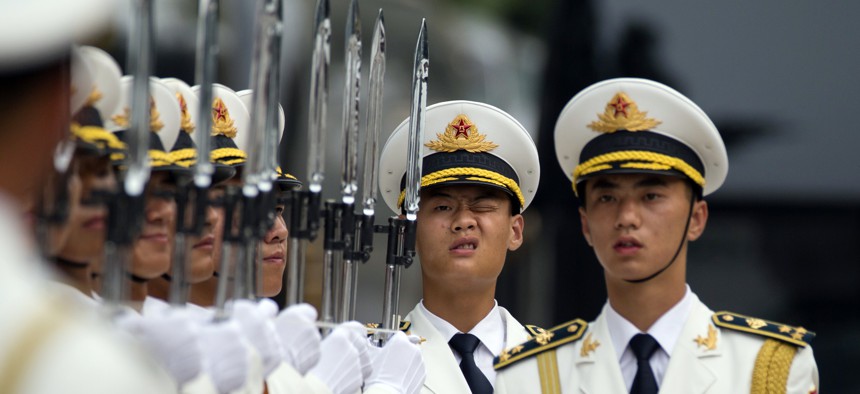
Members of a Chinese honor guard prepare for a welcome ceremony for the Belgium King in Beijing, Tuesday, June 23, 2015. Ng Han Guan/AP
Here’s the Biggest Difference Between US and Chinese Military Policy
What their public strategy documents say about the world’s leading military power and its up-and-coming rival.
On July 1, the U.S. published its new national military strategy, just a few months after China released its own. Both papers are intended for broad public consumption; neither addresses specifics about weapons and strategy. Taken together, they paint an interesting contrasting portrait of the military thinking guiding the two superpowers.
China’s document underlines a deepened commitment what it calls “civil-military integration.”
“And in response to the new requirement arising from China's all-round and deepening reform, the armed forces will continue to follow the path of civil-military integration (CMI), actively participate in the country’s economic and social construction, and firmly maintain social stability, so as to remain a staunch force for upholding the CPC’s ruling position and a reliable force for developing socialism with Chinese characteristics,” it states.
Further on, the strategy document mentions efforts to “coordinate national defense development and economic development and deepen the integration of the military and civil sectors … joint exploration of the sea, outer space and air, and shared use of such resources as surveying and mapping, navigation, meteorology and frequency spectra.”
This adds up to an argument for “the intertwining of civilian science and technology sectors with its military as necessary to gain a leading edge over any potential adversary,” writes privacy and international law researcher Heather Roff. “In short, it plans on embedding the military with everything.” What does that look like in real terms? An even more robust military-industrial complex than in the United States. But there’s something darker at work, too.
China has long been more focused on calming internal threats, or so-called “stability maintenance,” than outspending external enemies. If you think U.S. police are militarized, take a trip to Beijing. In 2014, China surpassed the U.S. as the world’s No. 1 market for surveillance equipment and technology. In 2011, as the Arab Spring was taking root across the Middle East, Beijing bumped spending on internal security by more than 13 percent to 624.4 billion yuan ($95 billion). That outpaced the budget for the Chinese Liberation Army, which rose 12.7 percent to 601.1 billion yuan. Not long after, China stopped publishing figures on how much it was spending for internal vs. external security. The CMI language in its new strategy document in many ways alludes to this continued focus on militarized policing as central to the country’s broader security strategy.
Contrast that with the U.S. military budget of $598 billion — far, far more than the Department of Justice (law enforcement) budget of about $30 billion. Consider also the content of the U.S. military strategy, which puts a special emphasis on the prolonged battles against terrorism: “We are more likely to face prolonged campaigns than conflicts that are resolved quickly… that control of escalation is becoming more difficult and more important… and that as a hedge against unpredictability with reduced resources, we may have to adjust our global posture.”
The United States is preparing for never-ending war abroad. In China, the focus is eternal war at home.




